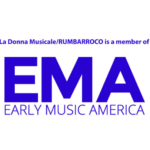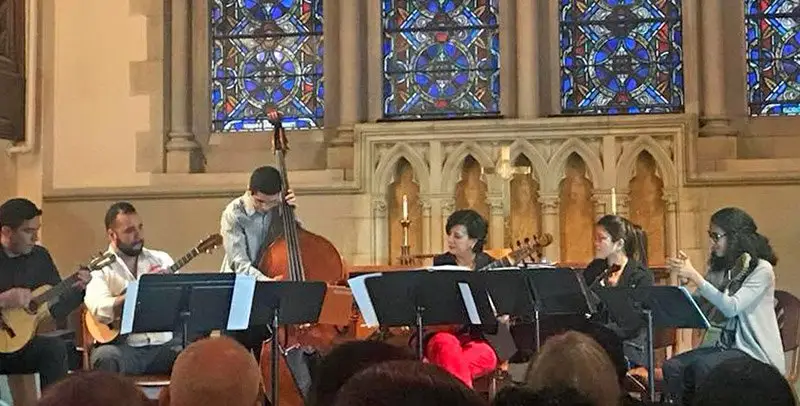PRESS
Concert reviews | La Donna Musicale
Devotional Songs To Sing at Home
“The Spirit Transformed: Women and 17th-Century Sacred Songs.”
Playlist

0:16

0:16

0:16
Revelations Archival and Modern by Liane Curtis
La Donna Musicale gave a recently discovered work by the Viennese nun Maria Anna von Racshenau (ca. 1650-1714) its first hearing over 300 years in a Friday program pairing Raschenau’s music with Camilla de Rossi’s (fl. 1700-1710); rediscovered several decades ago, her work remains too little known. Their contrasting works were full of exquisite musical moments, resulting in a rich and satisfying event.
Two Sopranos - Male & Female: Early Works by Women
“La Donna Musicale and Laury Gutiérrez, have built up a devoted following over the years, and they completely deserved the enthusiastic response they received.”
The Hub Review
“I couldn’t help but feel that Camilla de Rossi’s The Prodigal Son was something different. This isn’t just women’s-studies fodder; it really is a discovery; it’s simply a wonderful oratorio“
"La Donna Musicale gives women their due.”
“La Donna Musicale gives women their due.”
“Male or female, dead or alive, the bottom line was music of great beauty and power.”
– Clef Palette, March 2011
The musical women
“It’s all about women power”
“The variety of instrumental combinations worked beautifully with the talented vocal soloists throughout the performance.”
– Viola da Gamba Society of New England,Spring 2009
La Donna Musicale: Erudite, Spirited Prodigal Son
“Rossi’s (…) opens her work up to the erudite, spirited advocacy of La Donna Musicale… a triumphant modern premiere… incredible concert.”
La Donna Musicale's Passion and Virtuosity
“Here was music of such grandeur that it ought to be heard in Symphony Hall!”
Agnesi’s “Sophonisba” in first Modern Performance
“. . . a great victory in bringing her (Agnesi) – in this opera (Sofonisba) – back to life.”
Music of Renaissance women reborn at Radcliffe
“Scholar plucks composers out of the dark”
On a quest to give female composers their due
Laury GutiÈrrez has spent the last 16 years rescuing female composers from oblivion.
Group shares lost works by lady composers
“Group shares lost works by lady composers”
Music of Renaissance women reborn at Radcliffe
“Scholar plucks composers out of the dark”
On a quest to give female composers their due
Laury GutiÈrrez has spent the last 16 years rescuing female composers from oblivion.
Concert reviews | Rumbarroco
Dedication to the Complex Story
“Rumbarroco’s approach demonstrates vividly that Early Music has always been “global music,” as we can hear through the connections between the Iberian Peninsula, Africa, and the Americas— important intersections that continue to inform and influence numerous musical genres to this very day. Bravo to Rumbarroco for a well-thought-out and artistically executed program!”
Rumbarroco at BEMF Fringe
“This intersection of cultures gave the group an excitement and intensity that was refreshing to watch and hear. Seldom have I enjoyed a concert more.”
Tina Chancey.
Fandango Fiesta Is Memorable
“a virtual journal and essential blog of the classical music scene in greater Boston”
Euro-Latin Confluence Flows
“The exciting Für Elena by contemporary Diana Arismendi,; based on a folia harmonic progression typical of the Baroque, showcased an intriguing free interplay among violin, viola da gamba, and bass, ending with an extraordinary cadenza by violinist Yi-Li Chang”
Rumbarocco Grooves with Baroque
“The ensemble’s holiday offering at First Lutheran Church Boston on Friday also served to celebrate its newest CD release. Gutiérrez began by inviting the audience to clap the clavé rhythm as an invocation to what would become a lively evening of dance and virtuosic talent. Before long, the entire audience was moving in rhythm to the ensemble’s lively opener”
Rumbarroco bridges early music and Latin rhythms delightfully
Rumbarroco put on a stellar show for a packed hall Saturday night at St. Martha’s Church in Miami Shores. An ensemble of world-class musicians, the group focuses on intercultural fusion between musical traditions, including early European music of the Renaissance and Baroque and its confluence with the music of the Americas.
– Rumbarroco bridges early music and Latin rhythms delightfully
2014
LATIN FOLK, BAROQUE STYLE MIX IN UNIQUE FASHION
“I wanted to bring together all the cultures that are within many South Americans’ DNA”
News & Features
Gala Concert Celebrates Influential Book
Can a book start a revolution? If ever one did, this is it. The idea of celebrating the 25th anniversary of an innovative anthology emerged when a group of musicians/scholars at the Women’s Studies Research Center at Brandeis recently reflected on its value
The Prodigal Son by a Woman Composer
La Donna Musicale, the Baroque ensemble that is devoted to recovering music by women, will present the oratorio The Prodigal Son by Camilla de Rossi on March 17 at Lindsey Chapel of Emmanuel Church in Boston, and on March 18 at the Radcliffe Institute Gymnasium, Cambridge
Agnesi’s “Sophonisba” in first Modern Performance
Maria Teresa Agnesi, an eighteenth-century child prodigy in Milan, attracted the interest of noble patrons, including another Maria Theresa, Empress of the Holy Roman Empire.
Reminiscences on the Musical Year Past
As the old year wanes, many of us are subject to bouts of introspection. The several BMInt writers who are not immune to that tendency have each submitted lists of three of their favorite CDs and concerts of the last season.
Fall 2007, A French Taste for Boston’s Festival, Early Music America journal, Volume 13, No 3.
ARS awards and concerts aplenty during the Boston Early Music Festival, Bits & Pieces
August 2006 review of La Donna Musicale’s Swiss concert, Der Murtenbieter
June 26, 2003, Bay Windows newspaper Performance Review, Boston Early Music Festival.
August 2004 article on La Donna Musicale by the Boston Globe.
CD reviews
Recording Reviews
Fusion” alludes to both the collaboration and the resulting music. A Spanish villancico shows rhythmic influences from Africa. Hildegard von Bingen’s liturgical songs are set to Cuban bolero-son.
CD Review by Andrew J. Sammut, April 20, 2020

“The music is ravishing… The voices of La Donna Musicale are all perfect exponents of the French Baroque style, and the instrumentalists make equally lovely contributions… very highly recommended.
– September 2011

EARLY MODERN WOMEN
“(it) reflects the ensemble’s firm grounding in the archival and scholarly world…the album is notable for its nuanced interpretations…a pleasure to hear…”
– December 2010
Our Anna Bon CD is the winner of the Arts and Media category by The Society for the Study of Early Modern Women.
JOURNAL OF THE MUSIC LIBRARY ASSOCIATION
Anna Bon: La virtuosa di Venezia
– December 2010
Note: Quarterly Journal of the Music Library Association is considered the foremost scholarly journal for music libraries and librarianship.

AMERICAN RECORD GUIDE
“… trail-blazing sampler of the music Bon has left us . . . a musical personality of interest, even beyond her gender… ”
–Sept/Oct 2010
“… excellent performance of delightful music of an enigmatic composer.”
– Winter 2010

“…Collectors of French Baroque music are in for a revelation with these two discs…”
– Nov/Dec 2009

“Their work is of top quality, with particularly fine attention to French diction and stylistic feeling. The sound is strong and vivid. The booklet includes full texts with translations, plus excellent notes… an altogether outstanding release.”
– Nov/Dec 2009

“(the) ensemble plays with all the elegance and panache one has come to expect of them?”
– Winter 2007
INTERNATIONAL RECORD REVIEW
TThe Pleasures of Love and Libation, Airs
by Julie Pinel and other Parisian women.
– June 2007

INTERNATIONAL RECORD REVIEW
The Seven Psalms of David, Vol.I and Vol. II reviews in International Record Review
– April 2007

“Kudos to La Donna Musicale as they champion the unheard music of women composers.”
– Winter 2007

The Seven Psalms of David, Vol.II reviews in Early Music America magazine
– Summer 2006

EARLY MUSIC MAGAZINE
The Seven Psalms of David, Vol. I review in Early Music magazine,
– May 2006, Vol. 34, No. 2

GOLDBERG MAGAZINE
The Seven Psalms of David, Vol.II four-star reviews in Goldberg magazine
– Spring 2006


EARLY MUSIC AMERICA
“La Donna Musicale performs these works with warmth and impeccable accuracy… Highly recommended…”
– The Seven Psalms of David, Vol.I review in Early Music America magazine, Spring 2005


Laury Gutierrez led Latin-Baroque Fusion Ensemble Rumbarroco’s “Fiestas & Fandangos from Old Iberia and the New World,” a fusion of Mexican, Guatemalan, Venezuelan and Dominican rhythms mixed with 16-17th century compositions by Diego Ortiz, Santiago de Murcia, Rafael Antonio Castellanos and Antonio Soler at the intimate Gordon Chapel of Old South Church on Sunday. A mysterious Arabic style chant by Daniela Tošic began issued from the back of the church after the captivating entrance of the instrumentalists playing a fusion of 3 different compositions Fandango/Gavan/Fandanguito by Santiago de Murcia (1673-1739). In the middle of the fandango, with the vibrant solos on Venezuelan Cuatro (folk guitar) by Carlos Sulbaràn and bandola by Roberto Pèrez took over the spotlight. Violinist Yi-Li Chang’s approach felt slightly too classically controlled and although technically proficient it lacked the sheer feeling of fandango fiddle. As the ensemble transitioned to Fandanguito, one could hear the combination of Arabic, European and American musical influences in Gutièrrez’ arrangements along with Mexican rhythms and scales.
Rumbarroco followed up with an oldest composition in the program by Diego Ortiz (1510-1570). Gutierrez introduced ensemble’s arrangement based on composer’s famous book on the art of improvisation “Trattado de Glosas” where he’s trying to explain how to freely expand one’s musical ideas on various chords progressions. The concept is more tied to jazz style nowadays, but this particular approach has been around with us for hundreds of years. They chose a basic Recercada Primera based on 3 chord harmonic progression and applied a folk rhythm of Merengue Dominicano. (Merengue is a type of music and dance originating in the Dominican Republic, which has become a very popular genre throughout Latin America.
In the United States it was first popularized by New York-based groups and bandleaders like Rafael Petiton Guzman, beginning in the 1930s) Luis Celis (bass) performed a contemporary solo in jazz style which was somewhat off-style for this particular piece, but indeed imaginative and very refreshing to audience’s ears. The composition led to a new upbeat tempo followed by Fabiola Mèndez solo on cuatro. Charismatic chromaticisms and solid control of the instrument transferred us to Puerto Rico leaving the listeners pleasantly “jet-lagged” from the variety of styles presented in this arrangement.
Cumbees con Currulao by Santiago de Murcia started with enchanting dance groove in 3/4 performed by Carlos Sulbaràn on percussion. Right in the middle of the piece the arrangement took an interesting turn when the groove suddenly stopped, and Fabiola Mendez began her solo of the original Murcia’s composition for baroque guitar, this time playing beautifully on Puerto Rican cuatro. Her high energy, accuracy and technical proficiency lead us back to the Currulao, a musical genre which references to the folkloric dance of Columbia. Traditionally it is known as old bambuco—a dance oriented towards courtship.

Latin-Baroque fusion kept us alert and enthused with an energetic arrangement of Rafael Antonio Castellanos (1725-1791) Vaya de Xacaras con Periquera. I couldn’t help but marvel the rhythmical solidity of Roberto and Carlos which was a backbone of the ensemble throughout the whole concert. They were able to teleport the listeners to the center of Venezuelan music and dance fiesta known as Joropo (Spanish word joropo meant “a party”, but now it has come to mean a type of music and dance that identifies Venezuelans).
Another Santiago de Murcia piece Los Ympossibles followed, but this time mixed with a famous Mexican folk song La Lloroncita. Tošic’s vocals captured the essence of the Mexican song with apparent ease of execution. Fabiola Mendez on Puerto Rican cuatro delivered yet again a tasteful and engaging instrumental solo.
Throughout, Rumbarroco honored the audience by invoking exploratory mood that invited each listener to create relationships to the music of various cultures, Dominican, Venezuelan, Mexican and others. Finally came the Fandango con Pajarillo by Antonio Soler (1729-1783). A long piece fused with ensemble’s favorite style, Joropo Venezolano started out just like the first piece, with a mysterious tremolo on a single chord followed by fantasy-like improvisation on bandola reminiscing the Arabic oud. The ensemble introduced the fandango chord progression and dived right into the Venezuelan fiesta followed by luminous violin passages, up-lifting castanets and flashy strumming techniques by plucked strings. The fiesta came to a sudden stop and just as the silence before the storm the ensemble started slowly building the atmosphere of a Spanish bullfight where Roberto Perez being a toreador on bandola was pushing and pulling through each phrase as if teasing the bull to its absolute limit. Carlos Sulbaran had an answer on a tiny Venezuelan cuatro, the sheer intensity and control of rasgueado technique allowed the instrument to shine in a way I’ve never heard before. Truly my favorite moment of the whole show which kept my heartbeat rushing as if standing right in front of a bull! The audience went wild demanding for an encore. Rumbarroco complied with Plena by Diana V. Saez which included the listeners, diving them in 2 groups and singing along the composition. This music may be less familiar to the audiences, but it certainly needs more exposure and Gutierrez’s ensemble has done magnificent work in educating the listeners as well as giving us an unforgettable Fandango fiesta.
Renaissance Lutenist, Classical Guitarist, Arranger, Composer, Educator and Audio Engineer, Jonas Kublickas completed his Master’s Degree at New England Conservatory in Classical Guitar Performance under Eliot Fisk.
Fandango Fiesta Is Memorable










